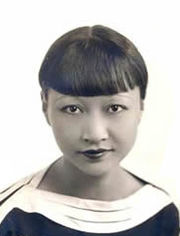Anna May Wong's Human Design Chart
4/6 Emotional Manifestor**Anna May Wong: A Trailblazing Actress and Manifestor in Hollywood**
Anna May Wong, born on January 3, 1905, in Los Angeles, California, is celebrated as the first Chinese American Hollywood movie star and the first Chinese American actress to achieve international acclaim. Her remarkable career spanned silent films, sound films, television, stage, and radio, showcasing her versatility and talent. As a Manifestor in Human Design, Wong embodied the qualities of initiation and creativity, often paving her own path in an industry that frequently sought to confine her to stereotypical roles.
Wong’s presence was first felt in the 1924 film *The Thief of Baghdad*, where her captivating performance left a lasting impression. By the same year, she had become a fashion icon, achieving international stardom. However, as an Emotional Manifestor, she faced the frustration of being relegated to supporting roles that did not reflect her true potential. This emotional authority led her to make the bold decision to leave Hollywood for Europe in the late 1920s, where she starred in significant works like *Piccadilly* (1929), showcasing her ability to inform and inspire through her art.
Throughout the early 1930s, Wong traveled between the United States and Europe, continuing to break barriers in films such as *Daughter of the Dragon* (1931) and *Shanghai Express* (1932) alongside Marlene Dietrich. In 1935, Wong faced a significant setback when Metro-Goldwyn-Mayer overlooked her for the lead role of O-Lan in *The Good Earth*, choosing a white actress instead. This disappointment prompted her to reconnect with her roots by touring China and studying her family’s heritage, a journey that resonated with her 4/6 profile in Human Design, emphasizing her role as a role model and her desire to build connections.
In the late 1930s, Wong took on several B movies for Paramount Pictures, portraying Chinese and Chinese Americans in a positive light. During World War II, she shifted her focus from her film career to humanitarian efforts, dedicating her time and resources to support the Chinese cause against Japan. This period of selfless service reflected her emotional authority, as she prioritized her values over personal ambition.
Wong made a triumphant return to the public eye in the 1950s, notably with her groundbreaking television show *The Gallery of Madame Liu-Tsong*, which marked the first U.S. television series starring an Asian American lead. Off-screen, Wong was known for her proud and independent spirit, famously stating, “No, I am wedded to my art,” when questioned about marriage.
Tragically, Anna May Wong passed away from a heart attack in 1961 at the age of 56 in Santa Monica, California. For years following her death, she was often remembered for the stereotypical roles she portrayed, such as the “Dragon Lady” and the demure “Butterfly.” However, her legacy has been re-evaluated in recent decades, particularly around the centennial of her birth, with renewed recognition of her contributions to cinema and culture.
As a Manifestor with the Right Angle Cross of Tension (38/39 | 48/21), Wong’s life and career exemplified the power of initiating change and challenging societal norms. Her channels—26-44, 21-45, and 37-40—further highlight her unique ability to communicate and connect deeply with others, solidifying her place as a pioneering figure in Hollywood history. Anna May Wong’s story is not just one of artistic achievement but also a testament to the transformative power of following one’s emotional truth and inspiring others along the way.
Discover More Famous People
Browse and analyze over 55,000 public figures and celebrities.
Ra Uru Hu
5/1 Manifestor
Martha Stewart
4/6 Manifestor
David Lynch
4/6 Generator
Barack Obama
6/2 Projector
Steve Jobs
6/3 Generator
Vladimir Putin
5/1 Manifestor
Kim Kardashian
3/5 Generator
Michael Jackson
1/3 Projector
Marilyn Monroe
6/2 Projector
Ariana Grande
2/4 Projector
Oprah Winfrey
2/4 Generator
Johnny Depp
2/4 ManifestorWhat is HumanDesign.ai and how does it work?
Curious what makes Anna May Wong tick? HumanDesign.ai instantly maps their exact birth data into a fully interactive clickable bodygraph chart, letting you hover or tap every center, channel, and gate for plain-language explanations. Bella, the platform’s built-in AI guide, adds context in real time, translating complex mechanics into everyday insights so you can see how Anna May Wong’s strengths, challenges, and life themes play out on-screen.
The same tools are waiting for you. Generate your own Human Design Chart in seconds, open a library of 2000+ suggested questions, and chat with Bella as often as you like to decode your design, daily transits, and even relationship dynamics.
Want to compare energies? Save unlimited charts for friends, family, or clients, then ask Bella to reveal compatibilities, composite patterns, or coaching tips, all in one conversation thread.
Start free with core features, or unlock our Personal and Pro plans for deeper dives: unlimited Q&A, celebrity chart search spanning 55,000+ public figures, white-label PDF reports, branded content generation, and a professional profile with built-in booking for practitioners. Whether you’re exploring your own potential or guiding others, HumanDesign.ai delivers an ever-expanding toolbox of AI-powered insights—no spreadsheets, no jargon, just clarity at your fingertips.
Ready to see yours? Signup for FREE today!

